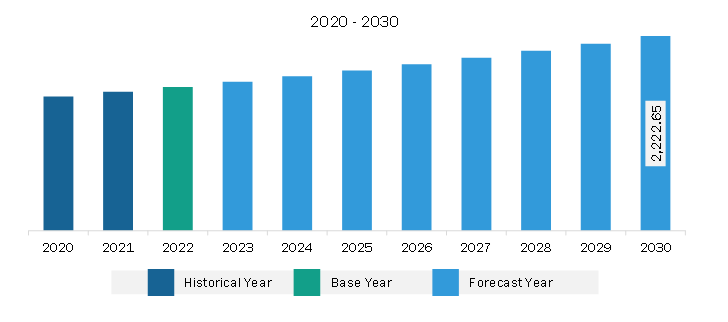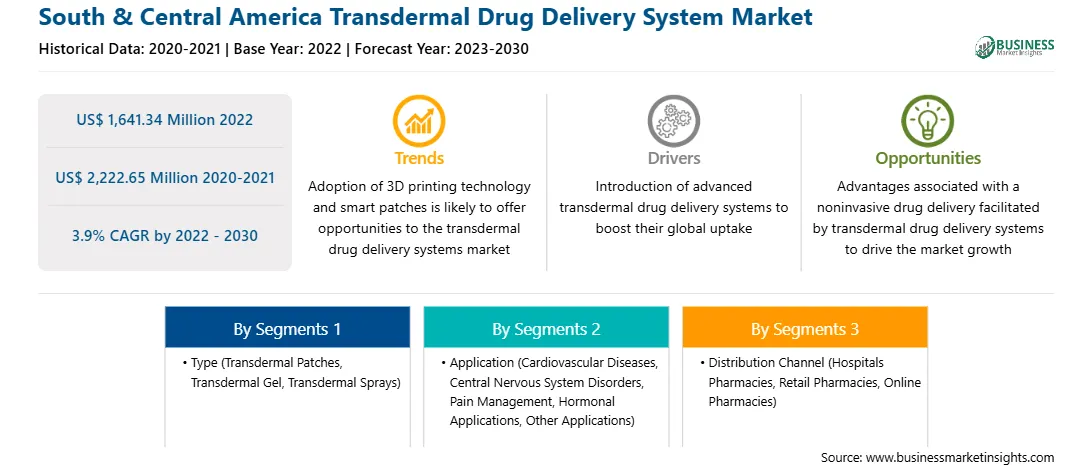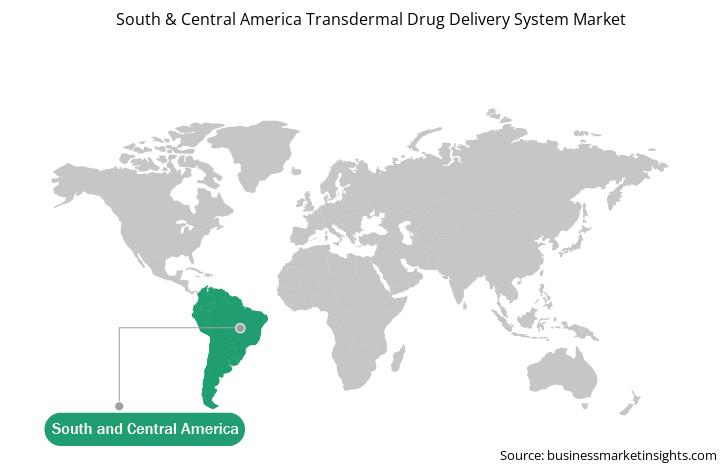The South & Central America transdermal drug delivery system market is expected to grow from US$ 1,641.34 million in 2022 to US$ 2,222.65 million by 2030. It is estimated to register a CAGR of 3.9% from 2022 to 2030.
Advancements in Smart Patches and 3D-Printed Patches Fuel South & Central America Transdermal Drug Delivery System Market
A transdermal drug administration route is novel and one of the reliable means of sustained drug delivery. With significant research being conducted in this field and the increasing interest of researchers in this form of drug delivery, a large number of transdermal patches are likely to reach the marketplace in the future. Transdermal patches are used to deliver drugs such as nicotine, fentanyl, nitroglycerin, and clonidine to treat various medical conditions. Recently, these patches have been explored to deliver biologics in various applications. Smart patches are equipped with sensors and other technologies to monitor patient conditions and adjust drug delivery accordingly. In January 2023, a lead scientist at Swansea University developed a new smart patch to detect proinflammatory biomarkers of neurodegenerative diseases such as Parkinson's and Alzheimer's using the microneedle technology. These smart patches comprise numerous microneedles designed to penetrate the skin barrier in a minimally invasive manner, followed by monitoring the biomarkers of clinical significance. They can be self-administered for point-of-care diagnosis at general practices or at home. This innovative research can potentially change the landscape of early neurodegenerative disease detection.
According to an article titled "3D-Printed Products for Topical Skin Applications: From Personalized Dressings to Drug Delivery," published in the National Library of Medicine in November 2021, personalized 3D-printed patches that conform to the skin surface can be used for acetyl-hexapeptide 3 (AHP-3) delivery. In this study, two liquid monomers-polyethylene glycol diacrylate (PEGDA) and vinylpyrrolidone (VP)-were used in different proportions to improve the mechanical strength, polymerization rate, and swelling rate of the final polymer. Optimal drug loading on the resin indicated that AHP-3 remained stable throughout the manufacturing process and had no effect on the physical properties of the final polymer. Using a 3D scanned facial model, a personalized patch was designed in computer-aided design software, and it was fabricated in optimized resin using a digital light processing 3D printer. The in-vitro characterization of prepared transdermal patches has shown their ability to penetrate human cadaver skin, further remaining intact upon compression. "3D-Printed Products for Topical Skin Applications: From Personalized Dressings to Drug Delivery" is the first study demonstrating personalized patches made using photopolymers, and it has introduced a novel approach to improve the transdermal delivery of drugs for effective wrinkle management.
Thus, the adoption of 3D printing technology and smart patches is likely to offer opportunities to the transdermal drug delivery systems market in the coming years.
South & Central America Transdermal Drug Delivery System Market Overview
The transdermal drug delivery system market in South & Central America includes a country-level analysis of Brazil, Argentina, and the Rest of South & Central America. Brazil is expected to have a significant market share in this region. Also, it is projected to grow at the highest growth rate. The regional growth is attributed to growing research, increasing disease modeling, and the prevalence of diabetes and cardiovascular diseases. Also, the development of novel and innovative technologies for medical treatment provides lucrative opportunities for the transdermal drug delivery systems market to grow. The rising prevalence of cardiovascular diseases and diabetes in Brazil is expected to yield the development of novel products over the forecast years. According to the International Diabetes Federation, in 2021, the age-adjusted comparative prevalence of diabetes in Brazil was 8.8% and is expected to increase to 10.2% by 2030 and 10.9% by 2045. Diabetes is one of the most acute epidemic diseases responsible for several coronary heart diseases. This rising diabetes prevalence has translated into a 60% growth in the related risk ratio for cardiovascular diseases associated with diabetes. Thus, the high prevalence of CVDs and diabetes will likely increase the demand for transdermal drug delivery systems, thereby propelling the market growth.
Brazil's private and public organizations focus on strategic activities to develop the business for the transdermal drug delivery systems. According to a report titled "Web-based decision-making tool for smoking cessation (Pare de fumar conosco) among patients with chronic conditions in Brazil," published by the National Library of Medicine in January 2020, the smoking cessation web-based tool significantly increased interest in pharmacotherapy and behavioral counseling. As per a report titled "The National Commission for FCTC Implementation in Brazil (Conicq)," published in October 2022, the Ministry of Health-with the support of the Oswaldo Cruz Foundation, INCA, and other institutions-is developing a protocol to prevent, diagnose, and treat occupational risks for tobacco growers and their families. Also, the private and public organizations in the country are focused on strategic activities to develop the business for transdermal drug delivery systems. For instance, the Brazil Health Ministry has signed an agreement with India-based Rusan Group for the smoking cessation program. Under the agreement, Rusan's 2baconil drug will be used for the Brazilian government's agenda for smoking cessation in the country.
Thus, Brazil possesses vast potential for developing novel and innovative technology and is expected to witness promising growth in the transdermal drug delivery systems market during 2022-2030.
South & Central America Transdermal Drug Delivery System Market Revenue and Forecast to 2030 (US$ Million)
Strategic insights for the South & Central America Transdermal Drug Delivery System provides data-driven analysis of the industry landscape, including current trends, key players, and regional nuances. These insights offer actionable recommendations, enabling readers to differentiate themselves from competitors by identifying untapped segments or developing unique value propositions. Leveraging data analytics, these insights help industry players anticipate the market shifts, whether investors, manufacturers, or other stakeholders. A future-oriented perspective is essential, helping stakeholders anticipate market shifts and position themselves for long-term success in this dynamic region. Ultimately, effective strategic insights empower readers to make informed decisions that drive profitability and achieve their business objectives within the market. The geographic scope of the South & Central America Transdermal Drug Delivery System refers to the specific areas in which a business operates and competes. Understanding local distinctions, such as diverse consumer preferences (e.g., demand for specific plug types or battery backup durations), varying economic conditions, and regulatory environments, is crucial for tailoring strategies to specific markets. Businesses can expand their reach by identifying underserved areas or adapting their offerings to meet local demands. A clear market focus allows for more effective resource allocation, targeted marketing campaigns, and better positioning against local competitors, ultimately driving growth in those targeted areas.
South & Central America Transdermal Drug Delivery System Strategic Insights

South & Central America Transdermal Drug Delivery System Report Scope
Report Attribute
Details
Market size in 2022
US$ 1,641.34 Million
Market Size by 2030
US$ 2,222.65 Million
Global CAGR (2022 - 2030)
3.9%
Historical Data
2020-2021
Forecast period
2023-2030
Segments Covered
By Type
By Application
By Distribution Channel
Regions and Countries Covered
South and Central America
Market leaders and key company profiles
South & Central America Transdermal Drug Delivery System Regional Insights

South & Central America Transdermal Drug Delivery System Market Segmentation
The South & Central America transdermal drug delivery system market is segmented into type, application, distribution channel, and country.
Based on type, the South & Central America transdermal drug delivery system market is segmented into transdermal patches, transdermal gel, transdermal sprays, and others. The transdermal gel segment held the largest share of the South & Central America transdermal drug delivery system market in 2022. The transdermal patches is further sub segmented into drug-in-adhesive patches, matrix patches, reservoir membrane patches, and vapor patches.
In terms of application, the South & Central America transdermal drug delivery system market is categorized into cardiovascular diseases, central nervous system disorders, pain management, hormonal applications, and other applications. The pain management segment held the largest share of the South & Central America transdermal drug delivery system market in 2022. The pain management is further sub segmented into opioid and non-opioid. The hormonal applications is further sub segmented into transdermal estrogen & progesterone therapy and testosterone replacement.
By distribution channel, the South & Central America transdermal drug delivery system market is segmented into hospitals pharmacies, retail pharmacies, online pharmacies, and others. The hospitals pharmacies segment held the largest share of the South & Central America transdermal drug delivery system market in 2022.
Based on country, the South & Central America transdermal drug delivery system market is segmented into Brazil, Argentina, and the Rest of South & Central America. Brazil dominated the South & Central America transdermal drug delivery system market in 2022.
Boehringer Ingelheim International GmbH, GSK Plc, Hisamitsu Pharmaceutical Co Inc, Johnson & Johnson, Novartis AG, and Viatris Inc are some of the leading companies operating in the South & Central America transdermal drug delivery system market.
1. Boehringer Ingelheim International GmbH
2. GSK Plc
3. Hisamitsu Pharmaceutical Co Inc
4. Johnson & Johnson
5. Novartis AG
6. Viatris Inc
The South & Central America Transdermal Drug Delivery System Market is valued at US$ 1,641.34 Million in 2022, it is projected to reach US$ 2,222.65 Million by 2030.
As per our report South & Central America Transdermal Drug Delivery System Market, the market size is valued at US$ 1,641.34 Million in 2022, projecting it to reach US$ 2,222.65 Million by 2030. This translates to a CAGR of approximately 3.9% during the forecast period.
The South & Central America Transdermal Drug Delivery System Market report typically cover these key segments-
The historic period, base year, and forecast period can vary slightly depending on the specific market research report. However, for the South & Central America Transdermal Drug Delivery System Market report:
The South & Central America Transdermal Drug Delivery System Market is populated by several key players, each contributing to its growth and innovation. Some of the major players include:
The South & Central America Transdermal Drug Delivery System Market report is valuable for diverse stakeholders, including:
Essentially, anyone involved in or considering involvement in the South & Central America Transdermal Drug Delivery System Market value chain can benefit from the information contained in a comprehensive market report.